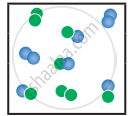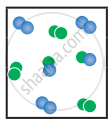Advertisements
Advertisements
प्रश्न
Derive a general expression for the equilibrium constant Kp and Kc for the reaction, \[\ce{3H2(g) + N2(g) <=> 2NH3(g)}\].
उत्तर
Let us consider the formation of ammonia in which, ‘a’ moles nitrogen and h’ moles hydrogen gas are allowed to react in a container of volume V. Let ‘x’ moles of nitrogen react with 3 x moles of hydrogen to give 2x moles of ammonia.
\[\ce{3H2(g) + N2(g) <=> 2NH3(g)}\]
| N2 | H2 | NH3 | |
| Initial number of moles | a | b | 0 |
| number of moles reacted | X | 3x | 0 |
| Number of moles at equilibrium | a -x | b - 3x | 2x |
| Active mass or molar concentration at equilibrium | `("a -x")/"V"` | `("b" - "3x")/"V"` | `(2x)/"V"` |
Applying law of mass action,
K2 = `(["NH"_3]^2)/(["N"_2]["H"_2]^3)`
= `("2x"/"V")^2/((("a - x")/"V")(("b" - 3"x")/"V")^3)`
= `("4x"^2/"V"^2)/((("a - x")/"V")(("b" - 3"x")/"V")^3)`
= `(4x^2"V"^2)/(("a - x")("b - 3x")^3)`
The equilibrium constant KP can also be calculated as follows:
`"K"_"P" = "K"_"C" ("RT")^(Delta"ng")`
Δng = np - nr = 2 - 4 = - 2
`"K"_"P" = (4x^2"V"^2)/(("a - x")("b - 3x")^3) xx ["RT"]^-2`
Total number of moles at equilibrium,
n = a - x + b - 3x + 2x = a + b - 2x
`"K"_"P" = (4x^2"V"^2)/(("a - x")("b - 3x")^3) xx ["PV"/"n"]^-2`
`"K"_"P" = (4x^2"V"^2)/(("a - x")("b - 3x")^3) xx ["n"/"PV"]^2`
`"K"_"P" = (4x^2"V"^2)/(("a - x")("b - 3x")^3) xx [("a + b - 2x")/"PV"]^2`
`"K"_"P" = (4x^2("a + b - 2x")^2)/("P"^2("a - x")("b - 3x")^3)`
APPEARS IN
संबंधित प्रश्न
Which one of the following is incorrect statement ?
K1 and K2 are the equilibrium constants for the reactions respectively.
\[\ce{N2(g) + O2(g) <=>[K1] 2NO(g)}\]
\[\ce{NO(g) + O2(g) <=>[K2] 2NO2(g)}\]
What is the equilibrium constant for the reaction \[\ce{NO2(g) <=> 1/2 N2(g) + O2(g)}\]
An equilibrium constant of 3.2 × 10-6 for a reaction means, the equilibrium is
\[\ce{[CO(H2O)6]^2+ (aq) (pink) + 4Cl- (aq) <=> [CoCl4]^2- (aq) (blue) + 6 H2O (l)}\]
In the above reaction at equilibrium, the reaction mixture is blue in colour at room temperature. On cooling this mixture, it becomes pink in color. On the basis of this information, which one of the following is true?
The equilibrium constants of the following reactions are:
\[\ce{N2 + 3H2 <=> 2NH3}\]; K1
\[\ce{N2 + O2 <=> 2NO}\]; K2
\[\ce{H2 + 1/2O2 <=> H2O}\]; K3
The equilibrium constant (K) for the reaction;
\[\ce{2NH3 + 5/2 O2 <=> 2NO + 3H2O}\], will be
For a given reaction at a particular temperature, the equilibrium constant has a constant value. Is the value of Q also constant? Explain.
What is the relation between Kp and Kc? Given one example for which Kp is equal to Kc.
When the numerical value of the reaction quotient (Q) is greater than the equilibrium constant, in which direction does the reaction proceed to reach equilibrium?
For the reaction, \[\ce{A2(g) + B2(g) <=> 2AB(g); \Delta H}\] is -ve.
the following molecular scenes represent differenr reaction mixture. (A-green, B-blue)
| Closed ← |
 |
 |
 |
| System | At equilibrium | (x) | (y) |
- Calculate the equilibrium constant Kp and (Kc).
- For the reaction mixture represented by scene (x), (y) the reaction proceed in which directions?
- What is the effect of an increase in pressure for the mixture at equilibrium?
1 mol of CH4, 1 mole of CS2 and 2 mol of H2S are 2 mol of H2 are mixed in a 500 ml flask. The equilibrium constant for the reaction Kc = 4 x 10-2 mol2 lit-2. In which direction will the reaction proceed to reach equilibrium?
